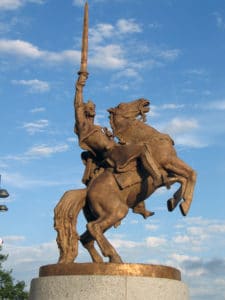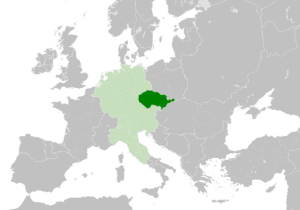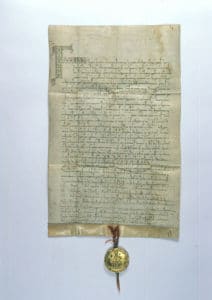Later in the 1st century, the Germanic tribes of the Marcomanni and Quadi settled there. Their king Maroboduus is the first documented ruler of Bohemia. During the Migration Period around the 5th century, many Germanic tribes moved westwards and southwards out of Central Europe. Most of the names of Czech rivers are Celtic or old Germanic in origin, dating from usage in those years.
Slavs from the Black Sea–Carpathian region settled in the area (their migration was pushed by an invasion of peoples from Siberia and Eastern Europe into their area: Huns, Avars, Bulgars and Magyars). In the sixth century, they moved westwards into Bohemia, Moravia, and some of present-day Austria and Germany.
During the 7th century, the Frankish merchant Samo, supporting the Slavs fighting against nearby settled Avars, became the ruler of the first known Slavic state in Central Europe, Samo’s Empire. The principality of Great Moravia, controlled by Moymir dynasty, arose in the 8th century. It reached its zenith in the 9th (during the reign of Svatopluk I of Moravia), holding off the influence of the Franks.

Great Moravia was Christianized, with a crucial role being played by the Byzantine mission of Cyril and Methodius. They created the artificial language Old Church Slavonic, the first literary and liturgical language of the Slavs, and the Glagolitic alphabet.
Bohemia:
The Duchy of Bohemia emerged in the late 9th century, when it was unified by the Přemyslid dynasty. In 10th century Boleslaus I, Duke of Bohemia conquered Moravia, Silesia and expanded farther to the east. The Duchy of Bohemia, raised to the Kingdom of Bohemia in 1198, was from 1002 until 1806 an Imperial State of the Holy Roman Empire alongside the Kingdom of Germany, the Kingdom of Burgundy, the Kingdom of Italy and numerous other territories such as the Old Swiss Confederacy and various Papal States. The kingdom was a significant regional power during the Middle Ages.

In 1212, King Přemysl Ottokar I (bearing the title “king” from 1198) extracted the Golden Bull of Sicily (a formal edict) from the emperor, confirming Ottokar and his descendants’ royal status; the Duchy of Bohemia was raised to a Kingdom. The bull declared that the King of Bohemia would be exempt from all future obligations to the Holy Roman Empire except for participation in imperial councils. German immigrants settled in the Bohemian periphery in the 13th century. Germans populated towns and mining districts and, in some cases, formed German colonies in the interior of Bohemia. In 1235, the Mongols launched an invasion of Europe. After the Battle of Legnica in Poland, the Mongols carried their raids into Moravia, but were defensively defeated at the fortified town of Olomouc. The Mongols subsequently invaded and defeated Hungary.

King Přemysl Otakar II earned the nickname Iron and Golden King because of his military power and wealth. He acquired Austria, Styria, Carinthia and Carniola, thus spreading the Bohemian territory to the Adriatic Sea. He met his death at the Battle on the Marchfeld in 1278 in a war with his rival, King Rudolph I of Germany. Ottokar’s son Wenceslaus II acquired the Polish crown in 1300 for himself and the Hungarian crown for his son. He built a great empire stretching from the Danube river to the Baltic Sea. In 1306, the last king of Přemyslid line Wenceslaus III was murdered in mysterious circumstances in Olomouc while he was resting. After a series of dynastic wars, the House of Luxembourg gained the Bohemian throne.
